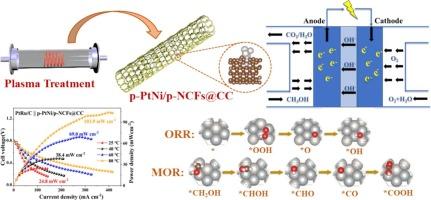等离子体缺陷工程增强PtNi纳米颗粒对碱性直接甲醇燃料电池的催化活性:机理研究
IF 13.2
1区 工程技术
Q1 ENGINEERING, CHEMICAL
引用次数: 0
摘要
氧还原反应(ORR)和甲醇氧化反应(MOR)反应速率慢已成为制约碱性直接甲醇燃料电池(ADMFC)技术发展的主要问题之一。因此,合理设计和开发高效、稳定的ORR/MOR双功能催化剂具有重要意义,是推动ADMFC技术商业化的关键一步。本文通过两次射频(RF)等离子体处理合成了一种高效的双功能催化剂,其特点是在碳布上生长富缺陷氮掺杂碳纳米管,支持低价PtNi纳米颗粒(p-PtNi/p-NCFs@CC)。两次射频等离子体处理一方面在p- nfc表面产生了更多的缺陷,可以为装载更多的p-PtNi NPs提供更多的活性位点,另一方面,PtNi NPs还原为更多的低价态金属,提高了催化剂的催化活性。密度泛函理论计算证明,等离子体处理过程中产生的缺陷促进了PtNi NPs的沉积,增强了PtNi NPs与衬底之间的电荷转移,提高了催化剂的稳定性。等离子体处理的PtNi NPs的氧化态降低了ORR和MOR中限速步骤的活化能。当p-PtNi/p-NCFs@CC同时用作ADMFC的阴极和阳极时,它在80 °C下仍然表现出高达85.8 mW cm−2的峰值功率密度,具有优异的稳定性。与传统的20 wt% Pt/C商用催化剂相比,p-PtNi/p-NCFs@CC具有更优越、更稳定的ORR和MOR性能。这些发现不仅提供了一种直接适用于admfc的高性能催化剂,更重要的是,通过缺陷工程和等离子体辅助制造建立了一种全新的电催化剂合成范式。本文章由计算机程序翻译,如有差异,请以英文原文为准。


Plasma defect engineering for enhanced catalytic activity of PtNi nanoparticles for alkaline direct methanol fuel cells: Investigation of mechanisms
The slow reaction rates of oxygen-reduction reaction (ORR) and methanol-oxidation reaction (MOR) have become one of the major problems limiting the development of alkaline direct-methanol fuel-cell (ADMFC) technology. Therefore, the rational design and development of efficient and stable ORR/MOR bifunctional catalysts are of great significance and a key step to promote the commercialization of ADMFC technology. Here, an efficient bifunctional catalyst is synthesized by twice radio-frequency (RF) plasma treatments, which is characterized by defect-rich nitrogen-doped carbon nanotubes grown on carbon cloth supporting low-valent PtNi nanoparticles (p-PtNi/p-NCFs@CC). Twice RF plasma treatments on the one hand, create more defects on the surface of p-NCFs, which could provide more active sites for loading of more p-PtNi NPs, on the other hand, the reduction of PtNi NPs into more low valence state metals improved the catalytic activity of the catalyst. Density-functional theory calculations prove that the defects generated during plasma treatment promote the deposition of PtNi NPs, enhance the charge transfer between PtNi NPs and the substrate, and improve the stability of the catalysts. The reduced oxidation state of plasma-treated PtNi NPs is shown to lower the activation energy for rate-limiting steps in both ORR and MOR. When p-PtNi/p-NCFs@CC is used as both the cathode and anode of an ADMFC, it still exhibits a peak power density of up to 85.8 mW cm−2 at 80 °C with excellent stability. Compared with the conventional 20 wt% Pt/C commercial catalyst, p-PtNi/p-NCFs@CC exhibits superior and more stable ORR and MOR performance. These findings not only present a high-performance catalyst with direct applicability in ADMFCs, but more importantly, establish a fundamentally new paradigm for electrocatalyst synthesis through defect engineering and plasma-assisted fabrication.
求助全文
通过发布文献求助,成功后即可免费获取论文全文。
去求助
来源期刊

Chemical Engineering Journal
工程技术-工程:化工
CiteScore
21.70
自引率
9.30%
发文量
6781
审稿时长
2.4 months
期刊介绍:
The Chemical Engineering Journal is an international research journal that invites contributions of original and novel fundamental research. It aims to provide an international platform for presenting original fundamental research, interpretative reviews, and discussions on new developments in chemical engineering. The journal welcomes papers that describe novel theory and its practical application, as well as those that demonstrate the transfer of techniques from other disciplines. It also welcomes reports on carefully conducted experimental work that is soundly interpreted. The main focus of the journal is on original and rigorous research results that have broad significance. The Catalysis section within the Chemical Engineering Journal focuses specifically on Experimental and Theoretical studies in the fields of heterogeneous catalysis, molecular catalysis, and biocatalysis. These studies have industrial impact on various sectors such as chemicals, energy, materials, foods, healthcare, and environmental protection.
 求助内容:
求助内容: 应助结果提醒方式:
应助结果提醒方式:


